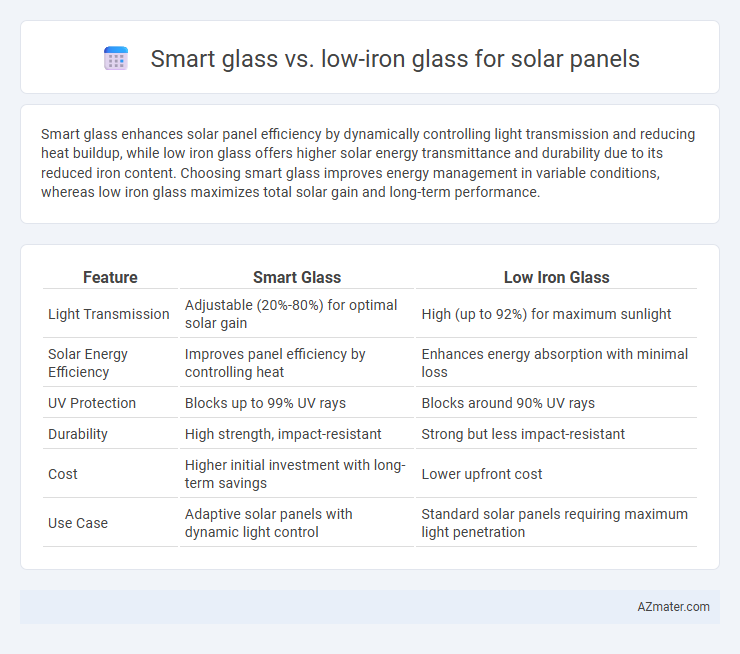Smart glass enhances solar panel efficiency by dynamically controlling light transmission and reducing heat buildup, while low iron glass offers higher solar energy transmittance and durability due to its reduced iron content. Choosing smart glass improves energy management in variable conditions, whereas low iron glass maximizes total solar gain and long-term performance.
Table of Comparison
| Feature | Smart Glass | Low Iron Glass |
|---|---|---|
| Light Transmission | Adjustable (20%-80%) for optimal solar gain | High (up to 92%) for maximum sunlight |
| Solar Energy Efficiency | Improves panel efficiency by controlling heat | Enhances energy absorption with minimal loss |
| UV Protection | Blocks up to 99% UV rays | Blocks around 90% UV rays |
| Durability | High strength, impact-resistant | Strong but less impact-resistant |
| Cost | Higher initial investment with long-term savings | Lower upfront cost |
| Use Case | Adaptive solar panels with dynamic light control | Standard solar panels requiring maximum light penetration |
Introduction to Smart Glass and Low Iron Glass
Smart glass enhances solar panel efficiency by dynamically controlling light transmission and heat, adapting to environmental conditions to optimize energy capture. Low iron glass offers high transparency and minimal color distortion, improving solar panel performance by maximizing sunlight penetration. Both types of glass play critical roles in solar technology, with smart glass focusing on energy management and low iron glass emphasizing optical clarity.
Importance of Glass Selection in Solar Panels
Glass selection critically impacts solar panel efficiency, as smart glass offers dynamic light modulation to optimize energy capture under varying sunlight conditions. Low iron glass maximizes light transmission by reducing iron content, enhancing solar cell performance through increased irradiance absorption. Choosing between smart glass and low iron glass depends on balancing energy yield, durability, and cost considerations for specific solar installations.
What is Smart Glass?
Smart glass, also known as switchable glass, is a dynamic material capable of changing its light transmission properties based on electrical, thermal, or solar stimuli, enhancing energy efficiency in solar panel applications. Unlike low iron glass, which offers higher transparency by reducing iron content to increase light absorption, smart glass actively regulates solar radiation, reducing heat gain and glare while optimizing electricity generation. This adaptive technology improves solar panel performance by modulating light intensity and thermal load, making it a sophisticated alternative for energy-conscious installations.
What is Low Iron Glass?
Low iron glass is a type of glass with reduced iron oxide content, typically less than 0.01%, resulting in higher transparency and minimal green tint compared to standard glass. It enhances solar panel efficiency by allowing more sunlight to pass through, improving energy absorption in photovoltaic cells. This makes low iron glass a preferred choice for solar panel covers when maximizing light transmission and power output is critical.
Light Transmission Efficiency Comparison
Smart glass and low iron glass differ significantly in light transmission efficiency for solar panels, with low iron glass typically offering higher transparency of around 91-92%, enhancing solar energy capture. Smart glass, designed for dynamic light modulation, often reduces light transmission to between 60-80% depending on its tint state, potentially lowering overall solar panel efficiency. Optimizing solar panel performance involves selecting low iron glass for maximum light transmission or smart glass when controllable light management is required without significantly compromising energy yield.
Energy Generation and Performance Differences
Smart glass for solar panels enhances energy generation by dynamically adjusting transparency to optimize sunlight absorption and reduce heat loss, leading to improved overall efficiency. Low iron glass offers higher solar transmittance compared to standard glass, boosting energy output by allowing more sunlight to reach photovoltaic cells, but lacks adaptive performance benefits. The choice between smart glass and low iron glass depends on specific performance goals, with smart glass providing real-time energy optimization and low iron glass delivering consistently high light transmission.
Durability and Weather Resistance
Smart glass designed for solar panels incorporates advanced coatings that enhance durability and resist UV degradation, ensuring long-term performance under harsh weather conditions. Low iron glass features high transparency and strength, offering excellent weather resistance, but may lack the dynamic responsiveness and protective properties found in smart glass. Both materials are engineered to withstand environmental stress, yet smart glass provides superior adaptability to temperature fluctuations and solar exposure, extending the lifespan of solar installations.
Cost Analysis: Smart Glass vs Low Iron Glass
Smart glass for solar panels typically incurs higher upfront costs due to advanced materials and embedded technologies that enable light modulation, whereas low iron glass offers a more cost-effective alternative with enhanced transparency and reduced iron content improving solar efficiency. The manufacturing and installation expenses of smart glass significantly impact overall project budgets, making low iron glass preferable for large-scale solar installations seeking cost optimization. Maintenance costs remain comparable, but the energy savings potential of smart glass might justify its premium price in specialized applications.
Environmental Impact and Sustainability
Smart glass enhances solar panel efficiency by dynamically regulating light transmission, reducing energy consumption and lowering carbon footprints compared to traditional glazing. Low iron glass offers superior clarity and durability, improving solar panel performance and longevity while minimizing resource waste and environmental degradation. Both materials support sustainability, but smart glass provides adaptive energy savings, whereas low iron glass ensures consistent high solar energy capture with minimal material impurities.
Which Glass is Best for Solar Panels?
Low iron glass is generally considered best for solar panels due to its higher light transmittance, typically above 91%, which maximizes solar energy absorption and efficiency. Smart glass, while offering adjustable transparency and thermal control, usually has lower light transmission, reducing overall solar panel performance. For optimal energy output and durability, low iron glass with anti-reflective coatings is the preferred choice in solar panel manufacturing.

Infographic: Smart glass vs Low iron glass for Solar panel
 azmater.com
azmater.com